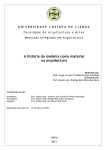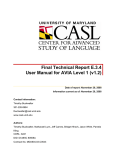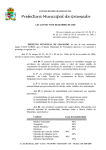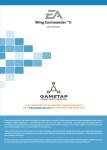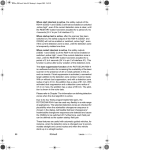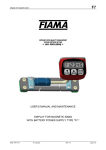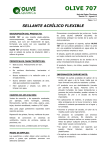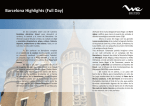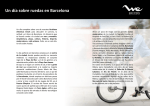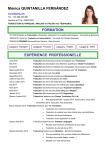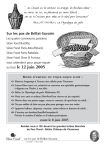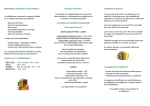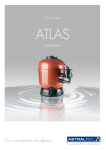Download Magazine - Carlos Castilho Pais
Transcript
Editores :: Editors Margarida Fonseca e Silva Sílvio Oliveira Textos :: Texts philos Colaboração especial :: Special collaboration Carlos Castilho Pais Versão inglesa :: English version Thomas Kundert Design Vitor Silva Fotografia :: Photos Sílvio Oliveira Publicação :: Publisher edições philos a viagem pela palavra the right word in the right place www.philos.pt [email protected] Esta publicação bilingue, de distribuição gratuita, isenta de publicidade, é exclusivamente electrónica e destinada ao universo dos nossos parceiros comerciais. This bilingual publication is delivered free, by electronic means only and to our business partners. No publicity included. Copyright - philos 2004 2 3 1;2;4 Barcelona 1 3 Soajo CONTRA A CORRENTE 4 :: AGAINST THE CURRENT 3 Clientes de testes Test clients QUESTÕES DE QUALIDADE :: QUALITY ISSUES 4 Avaliação da Qualidade Quality Assessment EM PORTUGUÊS :: IN PORTUGUESE 5 Crónica de Carlos Castilho Pais Chronicle by Carlos Castilho Pais “...DA OCIDENTAL PRAIA LUSITANA” :: “...FROM THE WESTERN LUSITANIAN SHORE” 6 Sentinelas inconfundíveis duma aldeia fundada no século I Unique sentinels of a village founded in 1 AD EVENTOS :: EVENTS: 7 Web 2.0 – Encontro na Universidade do Minho Web 2.0 – Meeting at Minho University GOSTA DE FLORES? :: ARE YOU A FLOWER FAN? 8 Em terras ácidas, as flores têm predominantemente o tom azul On acidic land the flowers are predominantly blue PASSATEMPO :: FOR FUN Escritor e poeta amigo de Petrarca, a sua obra-prima contém no título o número dez... A writer and poet friend of Petrarch, his masterpiece contains number ten in the title TRADUMÁTICA :: TRADUMATICS 9 Agora sem... rato! Hands off the mouse! BILBLIOTECA :: LIBRARY 10 (Re)leituras :: (Re)reading António Damásio... Ao Encontro de Espinosa António Damásio... Looking for Spinoza Poemas de Vida :: Lifetime Poems No alto da catedral de Gaudí, com Fiama Hasse Pais Brandão High above from Gaudí’s cathedral, with Fiama Hasse Pais Brandão DAQUI HOUVE NOME PORTUGAL :: FROM HERE PORTUGAL GOT ITS NAME 11 Seis séculos antes do Euro… Six centuries before the Euro… IMPRESSÕES DE VIAGEM :: TRAVEL MUSINGS 12 BARCELONA – O mundo de Gaudí BARCELONA – Gaudí’s world Setembro - September 2008 Contra a Corrente Against the Current Clientes de testes Como já anteriormente aqui tive ocasião de referir, a execução de testes faz parte do processo de avaliação dos candidatos a tradutores ou revisores da philos. É um procedimento normal, diria mesmo rotineiro, indispensável para avaliar se o candidato se enquadra ou não nos padrões de qualidade exigidos. Dado que os testes se destinam exclusivamente a fins de avaliação, não sendo prática do mercado a sua remuneração, temos a preocupação de elaborar baterias de testes provenientes de projectos já executados pela philos, razão por que os testes realizados por quaisquer candidatos nunca são objecto de qualquer utilização comercial. Tal como aplicamos esta prática aos que à philos se candidatam, aceitamos igualmente a mesma prática quando somos nós próprios candidatos a fornecedores de serviços de novos clientes. Neste caso, porém, a execução dos testes que os clientes não nos pagam, é paga pela philos aos colaboradores seleccionados para a sua execução, pois assumimos que este é um custo da empresa enquadrável nas despesas normais de desenvolvimento da sua actividade. Ora, como muito bem sabemos, nesta como em qualquer actividade, há de tudo no mercado, isto é, há empresas com ética e há, infelizmente, aquelas que preferem desconhecer o significado de tal palavra, como é o caso dos chamados “clientes de testes”. Há-os de todos os tipos: 1) O editor que transforma os 10 capítulos de um livro em 20 ou 30 “testes” a mandar executar gratuitamente por 20 ou 30 candidatos – depois lá está o revisor interno para dar alguma uniformidade ao livro e, entretanto, a tradução do mesmo foi "de borla"; 2) O fabricante de uma qualquer maquineta cujo manual de instruções pode igualmente ser traduzido pelo processo anterior; 3) Infelizmente, também algumas agências de tradução estão longe de ser modelos de ética e boas práticas, e há mesmo quem chegue ao desplante de solicitar testes de 3 ou 4 mil palavras... gratuitos, ou simbolicamente pagos a preços de revisão! É verdade que os já longos anos de experiência da philos nos permitem, em geral, detectar à partida os chamados “clientes de testes”. Mas também é verdade que, até nestas coisas, o mercado, nacional ou internacional, se vai sofisticando... para pior! Alerta, pois! Test clients As mentioned earlier here, the undertaking of tests is part of the assessment process for applicant translators or proof-readers of philos. It is an everyday routine process, which is indispensable to assess whether the applicant meets the quality standards demanded. Given that the tests are destined exclusively for assessment purposes, it is not common practice on the market to pay for them, and we make sure we have a set of tests from projects already executed by philos. Hence the tests carried out by any applicants are never used for business purposes. As we apply this practice to prospective philos staff, we also accept the same practice when we ourselves offer our services to new clients. In this case, however, the tests that the clients do not pay us for are paid by philos to the staff selected to do them, as we view this as a company cost in the category of normal expenses of our activity. As we all know, in this, as in any sector of activity, almost everything can be found on the market. There are companies who follow ethics and, unfortunately, there are those who prefer to ignore the meaning of the word, as is the case of the so-called “test clients”. There are all kinds: 1) The editor who transformed 10 chapters of a book into 20 or 30 “tests” distributed to 20 or 30 applicants – and then handing the returned texts to the internal proof-reader to make sure the book had a degree of uniformity, and meanwhile the translation was done for a “freebie”; 2) The manufacturer of a device whose instruction manual can also be translated using the previous process; 3) Unfortunately there are also translation agencies that are far from a model of ethics and good practice, and there are even those who have the nerve to request tests for documents containing 3 or 4 thousand words... free of charge, or paying a symbolic revision price! Our years of experience at philos generally allow us to detect “test clients” from the offset. But it is also true that even in these aspects the national or international market is getting more sophisticated, in the worse possible sense! Beware! Sílvio Oliveira Sócio Gerente - General Manager Setembro - September 2008 3 Questões de Qualidade Quality Issues Avaliação da Qualidade Quality Assessment Lembram-se de Raimundo Silva, revisor de livros, personagem principal de "História do Cerco de Lisboa", de José Saramago? Para quem não leu, além de recomendar vivamente a leitura, recordo que o revisor criado por Saramago introduz uma gralha na história do cerco de Lisboa, colocando em determinada frase (onde se afirmava que os cruzados ajudaram os portugueses a cercar Lisboa, tal qual nos ensina a História de Portugal) um não, resultando daí escrito que “os Cruzados não ajudaram os portugueses a sitiar Lisboa”. Em consequência do que se vê Raimundo Silva exonerado de funções e compelido a justificar essa sua gralha que, voluntariamente introduzida ou não, resulta numa nova versão da história do cerco de Lisboa, versão essa que, por ser contrária ao durante séculos estabelecido e historicamente aceite, profundamente revolucionaria os fundamentos da História de Portugal. Como eu o compreendo! Nós, tradutores profissionais, compreendemos bem o drama da personagem criada por Saramago. Porque, apesar das ferramentas automáticas de correcção ortográfica que a tecnologia coloca, hoje, ao nosso dispor, frequentemente somos forçados a aceitar que até mesmo elas, as ferramentas de última geração, são incapazes de detectar uma talvez pequena, mas que pode ser importantíssima parte daquelas malfadadas gralhas que escapam ao nosso “olhar de lince”... Uma delas, certamente a pior de todas, é a terrível pecha dos contrários. Acreditam que encontro, com surpreendente frequência, em trabalhos dos melhores tradutores, réplicas do drama de Raimundo Silva? A troca do “não” pelo “sim”, do “acima” pelo “abaixo”, do “espesso” pelo “fino”, do “esquerdo” pelo “direito”, do “ligar” pelo “desligar”, do “instalar” pelo “desinstalar”, do “primeiro” pelo “último” e uma infinidade de outros exemplos que aqui me dispenso de enumerar... bem, posso garantir-vos que é uma praga de tal modo contumaz que, fosse eu crente e já teria seguramente acendido um milhão de velinhas ao ilustre Eusebius Sophronius Hieronymus, vulgo São Jerónimo, padroeiro dos tradutores. Mais vos confesso que bastas vezes me tenho debruçado sobre o enigma, interrogando-me até que ponto a apagada e quase sempre desprezada tarefa de quem simplesmente deve verter para a sua língua as nem sempre brilhantemente redigidas ideias dos outros, não gerará no subconsciente do tradutor um secreto desejo de protagonismo que o leve a escrever o contrário do que deveria... hélas, com o risco das consequências que todos podem imaginar: por exemplo, já pensaram no que pode acontecer se mandarmos “subir” em vez de “baixar” a temperatura no manual de instruções destinado a um paciente em tratamento médico ou a uma máquina com risco de explosão? Não é, pois, por acaso que os contrários figuram como erro de extrema gravidade na tabela de avaliação da qualidade dos trabalhos executados pelos tradutores da philos. E não será com preces a São Jerónimo que resolveremos o problema, mas 4 apenas com trabalho: trabalho de releitura, sim, in-dis-pen-sá-vel. Se é verdade que a pressão dos prazos e as médias elevadas de produção são susceptíveis de fazer com que os tradutores cedam à tentação de "saltar etapas", a releitura é uma etapa obrigatória cujo voluntário ou involuntário esquecimento pode conduzir a prejuízos verdadeiramente irreparáveis. Reservar o tempo necessário para reler cuidadosamente o trabalho antes de efectuar a sua entrega, ou, em trabalhos mais longos, reler atentamente na manhã seguinte o trabalho traduzido no dia anterior - esta é, seguramente, a única “mezinha” que pode distinguir um tradutor profissional responsável e assegurar-lhe, a ele e aos seus clientes, um sono tranquilo. Dir-me-ão que o revisor é que está lá para isso mesmo: detectar as gralhas. Mas não devemos esquecer que o revisor sofre das mesmas pressões de prazos e quantidade de trabalho e, se “errar é humano”, humano é tanto o tradutor como o revisor... No mundo da tradução de máquina que progressivamente nos irá substituindo, é fundamental que todos, tradutores e revisores, sejamos capazes de controlar os erros humanos... De contrário, arriscamo-nos a ser, como Raimundo Silva, exonerados de funções, sem honra nem glória de poder reinventar a história. Do you remember Raimundo Silva, the proofreader and main character of the História do Cerco de Lisboa (The History of the Siege of Lisbon), by José Saramago? For those who have not read it – I strongly recommend you do so – the story entails the proof-reader created by Saramago inserting a mistake in the history of the siege of Lisbon, writing in a given sentence (where it was stated that the crusaders helped the Portuguese to encircle Lisbon, as we are taught in the History of Portugal) the words “did not”, resulting in the sentence “the Crusaders did not help the Portuguese to encircle Lisbon”. As a consequence Raimundo Silva is relieved of his duties and forced to justify his error; introduced voluntarily or not, the error results in a new version of the history of the siege of Lisbon, which would be in complete contrast to what has been historically accepted for centuries and profoundly revolutionise the foundations of the History of Portugal. How I understand him! We translators understand the drama of this character created by Saramago. Because despite the automatic spelling check tools provided by today’s technology, we are often forced to accept that these very tools, of the latest generation, are unable to detect the smallest of mistakes but which may be a vitally important misprint that escapes our “eagle’s eye”. One of them, certainly the worse of all, is the terrible scourge of the opposites. You would be amazed at the frequency I find, in the work of the best translators, replicas of Raimundo Silva’s drama. Changing a “no” to a “yes”, an “above” to a Margarida Fonseca e Silva Directora de Qualidade Quality Manager “below”, a “thick” to a “thin”, a “left” to a “right”, a “turn on” to a “turn off”, an “install” to an “uninstall”, a “first” to a “last” are just some of an infinite number of examples that I can guarantee is a plague that is so common that if I was a believer I would have already lit a thousand candles to the illustrious Eusebius Sophronius Hieronymus, Saint Jerome, the patron saint of translators. I add that I have dwelt on the enigma so many times that I even sometimes ask myself to what extent the low-key and almost always unappreciated task of rendering into one’s mother tongue the not always brilliant ideas written by others does not generate in the subconscious of translators a secret desire to be a protagonist which leads them to write the opposite of what they should... wow! at the risk of suffering the consequences you can imagine. For example, have you ever thought of what could happen if we ordered that the temperature be “raised” instead of “lowered” in the instruction manual written for a patient undergoing medical treatment or a machine that has a risk of explosion? It is not by chance that opposites are considered an extremely serious mistake in the quality assessment tables drawn up for the work carried out by philos translators. And it will not be by offering prayers to Saint Jerome that we get over the problem, but only through hard work: re-reading work is in-dis-pen-sable. While it is true that the pressure to meet deadlines and the high productivity needs are liable to tempt translators to “skip steps”, rereading is a compulsory step and failure to do so, by choice or through forgetfulness, can lead to truly irreparable damage. Reserving the time needed to carefully re-read the work before delivery, or with longer texts re-reading the translation the following morning, is without doubt the only “remedy” that distinguishes a responsible professional translator from others and guarantees that their clients can rest assured as regards the quality of the translation. You may say that the proof-reader’s job is to do just that: to detect mistakes. But we cannot forget that the proof-reader has the same time and work quantity pressures, and “making mistakes is only human” – the proof-reader is as human as the translator. In the world of machine translation that will progressively replace us, it is essential that everybody - translators and proof-readers – are able to control the human mistakes. Otherwise we risk being, like Raimundo Silva, relieved of our duties without the honour or glory of being able to reinvent history. Setembro - September 2008 Em português - In Portuguese Carlos Castilho Pais* Louvando e agradecendo a paciência dos meus leitores, anuncio que daremos, a partir de agora, nestas crónicas, maior atenção a um ramo de estudos que se desenvolveu significativamente a partir dos anos noventa do século passado – a História da Tradução. Datando a tradução de tempos imemoriáveis, escrever a sua história não se afigura uma tarefa fácil e, por isso mesmo, para muitos investigadores ela é tão aliciante. Para hoje, a reflexão que proponho encara a história do traduzir enquanto elemento que deve inscrever-se no conjunto dos actos a levar a cabo em prol da dignidade do tradutor. Não sei se me faço entender; o melhor será mesmo começar pelo enunciado da própria reflexão. O termo ‘dignidade’ não é meu; fui encontrá-lo em Valéry Larbaud, escritor francês do século XX, que ainda antes dos anos cinquenta publicava Sous l’Invocation de Saint Jérôme, uma obra que não deixa de inspirar-me e que continua, se não me engano, sem tradução para português. Para o escritor francês, a dignidade do tradutor não é ‘coisa’ que necessite de explicação ou de qualquer elemento de prova. Um tradutor é digno por natureza, como digno é o trabalho de traduzir. Trabalho de palavras, a tradução devia fazer parte de uma espécie de sociedade ou de organização que agrupasse todos os ofícios da palavra. Esta sociedade ou organização nomear-se-ia ‘república das letras’. A ‘dignidade’ do tradutor inscrever-se-ia nesta república das letras, que ombrearia, nem mais nem menos, com a ‘dignidade’ do escritor (e com a ‘dignidade’ de outros). Hoje, esta ideia de Larbaud parece uma ideia utópica, sabe-se lá porquê… E não exagero ao afirmar que para Larbaud, no concerto da república das letras, a ‘dignidade’ do tradutor era uma das maiores! O próprio afirma que teve a ideia de publicar um ensaio com o título ‘Da eminente dignidade dos tradutores na República das Letras’ (De l’éminente dignité des traducteurs dans la République des Lettres). Sendo assim, a história da tradução demonstraria, sem esforço, a dignidade dos tradutores. Neste sentido, o fazer da história da tradução nem sequer constituiria uma ‘estratégia’ da defesa da dignidade dos tradutores. Mas, e seguindo o exemplo de Larbaud – recordando o sermão de Bossuet, que falava da ‘eminente dignidade dos pobres na Igreja’ – no meio de tanta pobreza, de tanta pequenez com que se olha para a tradução, pergunto-me se não valerá a pena inscrever o fazer da história da tradução no conjunto das estratégias a desenvolver a favor da dignidade do tradutor e da tradução. De qualquer forma, um propósito poderia ser admitido por todos – um propósito favorável à inscrição da história da tradução nos curricula dos cursos universitários de formação de tradutores. Pois, mesmo aqui, têm existido algumas reticências. O ensino da história da tradução retiraria tempo, necessário à aprendizagem de técnicas de tradução. Uma visão tecnicista do ensino não lhe é favorável. Uma visão mais filológica, ao contrário, admite mais facilmente a história da tradução nos curricula de formação de tradutores. Será admissível que os próprios tradutores coloquem barreiras, objecções ou dúvidas ao ensino da história da tradução? Será necessário explicar aos tradutores a importância do estudo da história da tradução – a identificação dos tradutores de épocas mais ou menos remotas, as obras que se traduziram, o tipo de tradução que este ou aquele tradutor mais realizou, as concepções de tradução em vigor neste ou naquele momento, etc. – para uma estratégia de valorização da profissão ou da actividade de tradutor? Ninguém pode admirar o que desconhece. Mas pode admitir-se facilmente a riqueza da tradução em Portugal, bastando lembrar a época a que deram o nome de ‘Descobrimentos’. Nunca, ninguém antes dos portugueses, tinha constatado a existência de povos, de línguas e de culturas tão diversas. Uma NOVA TRADUÇÃO foi então necessária, para a língua portuguesa e, mais tarde, para outras línguas. Temos, por conseguinte, muita e boa matéria de reflexão para os próximos tempos. While praising and thanking my readers for their patience, I announce that from now onwards in this column greater attention will be given to a branch of studies that has advanced significantly from the 1990s – the History of Translation. Given that translation dates from time immemorial, writing its history is no easy task and as such not an enticing prospect for many researchers. For today the reflection I propose looks at the history of translation as one facet of a set of actions to be carried out aimed at infusing translators with the dignity they deserve. I’m not sure I am making myself understood; the best place to start is with the announcement of the reflection itself. The term ‘dignity’ is not mine; I found it written by Valéry Larbaud, a French 20th century author, who before the fifties had published Sous l’Invocation de Saint Jérôme, a work that constantly inspires me and which is yet, unless I’m mistaken, to be translated into Portuguese. According to the French writer, the translator’s dignity is not a “thing” that needs explanation or any element of proof. A translator is dignified by nature, just as the task of translating is dignified. Working with words, translation should be part of a kind of society or organisation that groups together all the professions centred on words. This society or organisation would be called the ‘Republic of Literature’. The translator’s ‘dignity’ would be an integral part of this Republic of Literature, which would rub shoulders with nothing less than the very author’s ‘dignity’ (and with the ‘dignity’ of others). Today, this idea of Larbaud’s seems some kind of utopia, for some strange reason… And it is no exaggeration to say that for Larbaud, in the concert of the Republic of Literature, the translator’s ‘dignity’ was one of the ones that burned brightest! He himself admits he had the idea to publish an essay entitled ‘Of the eminent dignity of translators in the Republic of Literature’ (De l’éminente dignité des traducteurs dans la République des Lettres). Therefore, the history of translation would demonstrate, without effort, the dignity of translators. Hence, compiling the history of translation would not even constitute a ‘strategy’ to defend the translators’ dignity. But, and in line with Larbaud’s example – with echoes of Bossuet’s sermon, who spoke of the ‘eminent dignity of the poor in church’ – in the midst of so much poverty, of so much disdain with which translation is viewed, I ask myself if it isn't worthwhile compiling the history of translation in the set of strategies to be carried out in the name of the dignity of the translator and translation. In any event, one purpose for further exploring the subject area can be accepted by all – the purpose of including the history of translation in the university curricula of translation degrees. Yet even in this field there has been an amount of reticence. Teaching the history of translation takes time away from the necessary learning of translation techniques. A purely technical view of education does not lend itself to this idea. A more philological view, in contrast, accepts the history of translation in the translation degree curricula without such question. Is it possible that the translators themselves construct barriers, objections or doubts in relation to the history of translation? Is it necessary to explain to the translators the importance of studying the history of translation – the identification of translators of distant or more recent epochs, the works that have been translated, the type of translation that this or that translator did, the concepts of translation in vogue at a certain moment, etc – towards a strategy of empowering the profession and the translator’s activity? Nobody can admire what he does not know. But one can easily find the wealth of translation in Portugal, by simply remembering the epoch that has been labelled the ‘Discoveries’. Never had anybody before the Portuguese verified the existence of such diverse peoples, languages and cultures. A NEW TRANSLATION therefore became necessary, into the Portuguese language and later into other languages. As a consequence we have abundant and excellent material for reflection over the coming times. * Professor universitário :: University Professor Setembro - September 2008 5 "... da Ocidental praia lusitana"* "… from the Western Lusitanian shore" *Luís de Camões (1524-1580) Por/By: Sílvio Oliveira Espigueiros do Soajo Granaries of Soajo Se ainda os não conhece, reserve uns dias de férias e vá até ao Soajo, a pequena aldeia comunitária implantada nesse tesouro de paisagem, de fauna e flora raras que o Parque Nacional da Peneda-Gerês nos oferece, bem no coração do Minho. Os 24 espigueiros do Soajo constituíam a eira comunitária da aldeia. Foram construídos quando a cultura do milho foi incrementada por essas bandas, destinando-se a armazenar o cereal, encimados pela cruz que invocava divina protecção. A mais antiga destas "despensas" ao ar livre data de 1782. Pitorescos monumentos de granito, alguns ainda em uso pelo povo da aldeia, os espigueiros do Soajo proporcionam um dos mais invulgares cenários nos contrafortes da Serra da Peneda, debruçada sobre o rio Lima. Diante deles se quedam hoje também os turistas, como diante de sentinelas inconfundíveis duma aldeia fundada no século I, que foi concelho até meados do século XIX e que continua a surpreender pela sua originalidade e beleza. Se não sabem o que era uma aldeia comunitária, sempre vos adianto que, até há cem anos atrás, a aldeia tinha um juiz eleito pelo povo... quanto ao resto, importa ir até lá, há muito mais a saber e a conhecer! If you have not yet been there, take some days off and go to Soajo, the small community village implanted in the midst of the fauna and flora of outstanding natural beauty which is the landscape of the Peneda-Gerês National Park, right in the heart of the Minho. The 24 granaries of Soajo make up the community threshing yard of the village. They were built when the cultivation of maize was increased to this area, in order to store the cereal, and are topped with a cross that invoked divine protection. The oldest of these open air “stores” dates back to 1782. Picturesque granite monuments, some still used by the villagers, the granaries of Soajo provide one of the most unusual scenarios on the embankments to be found in the Serra da Peneda, overlooking the River Lima. Today tourists descend on them, as with the unmistakable sentinels of a village founded in 1 AD, which was a council until the mid 19th century and which continues to surprise us with its originality and beauty. If you do not know what a community village was, I can let you in on the fact that until one hundred years ago the village had one judge elected by the population… as for the rest, you’ll have to go there, there is much more to learn! 6 Setembro - September 2008 Eventos Events Web 2.0 Encontro na Universidade do Minho Meeting at Minho University 10 de Outubro de 2008 - 10 October 2008 A Web 2.0 veio alterar o modo de publicação online, de construção de redes sociais e de social bookmarking, com repercussões na vida pessoal, na comunicação social, nas empresas e na educação. Exemplo da Web 2.0 são os blogues, os podcasts, os wikis, o Goowy, o Hi5, o Delicious, as ferramentas do Google, o YouTube, o Flickr, o Second Life, o Facebook, entre outros. Neste Encontro teremos conferências de: George Siemens, Graham Attwell, Manuel Pinto, António Moreira e Leonel Morgado com o objectivo de debatermos as implicações da Web 2.0 na actividade profissional e na aprendizagem. São proporcionados Workshops para os que queiram iniciar ou aprofundar a utilização de algumas das ferramentas da Web 2.0. Ficha de inscrição para participantes em: http://www.iep.uminho.pt/encontro.web2/ Web 2.0 has changed online publication, construction of social networks and social bookmarking, with repercussions on personal lives, the media, companies and education. Examples of Web 2.0 are blogs, podcasts, wikis, Goowy, Hi5, Delicious, Google tools, YouTube, Flickr, Second Life and Facebook, among others. This meeting will include speeches from: George Siemens, Graham Attwell, Manuel Pinto, António Moreira and Leonel Morgado to debate the implications of Web 2.0 on professional activity and learning. Workshops are organised for those who want to learn or perfect their skills with some Web 2.0 tools. Registration form for participants at: http://www.iep.uminho.pt/encontro.web2/ Setembro - September 2008 7 G o s t a d e f l o re s ? Are you a flower fan? H ortênsia H ydrangea Descoberta pelo botânico francês Philibert Commerson (1727-1773), a hortênsia pertence ao género hidrângea da família das saxifragáceas e é originária da China e do Japão. Introduzida em França onde hoje se encontra em grande profusão, sobretudo na região da Bretanha, é uma das flores mais populares nos nossos jardins. Nos Açores é de tal modo exuberante que é considerada invasora e perigosa para a flora nativa. A coloração das suas flores tem uma curiosa particularidade: em terras ácidas, as flores têm predominantemente o tom azul, sendo as melhores flores azuis obtidas a partir das variedades cor-de-rosa, que surgem em solos alcalinos. O vermelho, o roxo e o branco são também cores que encontramos numa infinita paleta de tons desta pródiga flor que embeleza as nossas paisagens desde a Primavera até ao Outono. Discovered by the French botanist Philibert Commerson (1727-1773), the hydrangea belongs to the genus of the Schizophragma family and originates from China and Japan. Introduced into France where it is today widespread, especially in the region of Brittany, it is one of the most popular flowers in Portugal’s gardens. In the Azores it is so exuberant that it is considered a dangerous invader for the native flora. The colouring of the flowers is particularly interesting: on acidic land the flowers are predominantly blue, with the best blue flowers obtained from pink varieties, which grow in alkaline soils. Red, purple and white are also found in the infinite pallet of tones of this prodigious flower that beautifies our landscapes from spring to autumn. Myosotis PASSATEMPO FOR FUN Escritor e poeta amigo de Petrarca, a sua obra-prima contém no título o número dez. Quem foi ele e a que obra nos referimos? Temos ofertas para as 3 primeiras respostas certas! Nota: a participação está vedada aos colaboradores internos da philos e seus familiares. ? A writer and poet friend of Petrarch, his masterpiece contains number ten in the title. Who was he and what work of art are we referring to? We have gifts for the first 3 people to send in correct answers! Note: philos' in-house team and their families are not allowed to participate. :: Edição anterior: Muitos são os leitores que se interessam pela astronomia, pois tivemos desta vez uma extraordinária afluência de respostas certas: a estátua representa Nicolau Copérnico e encontra-se na cidade de Varsóvia, frente à Academia Polaca das Ciências. Desta vez, além do Porto, foi para a República Checa e para Inglaterra que seguiram os "souvenirs" da philos: porcelana pintada à mão, de Viana do Castelo (ver também a pág. 6 da edição anterior). Last Issue: Many of our readers are interested in astronomy, as borne out in the extraordinary number of correct answers we received from our last issue: the statue represented Nicolaus Copernicus and stands in the city of Warsaw, in front of the Polish Academy of Sciences. This time, as well as Porto, the philos souvenir prizes went to the Czech Republic and England: handpainted porcelain from Viana do Castelo (see also page 6 in our previous Magazine) 8 Setembro - September 2008 Tradumática Tradumatics Agora sem... rato! Hands off the mouse! A rapidez de execução de algumas tarefas esbarra, por vezes, no recurso ao dispositivo apontador mais “popular” das últimas décadas. No Winword™ podemos fazer um sem número de coisas sem nunca tirar as mãos do teclado. Com toda a certeza, conhece os padrões: Ctrl+C para copiar, Ctrl+V para colar, Ctrl+Z para desfazer, Ctrl+T para seleccionar tudo e Ctrl+P para imprimir, mas existe uma lista de outros atalhos que podem ser preciosos auxiliares do relógio e da concentração. Na tabela abaixo vai encontrar alguns dos muitos disponíveis no Winword™. Verá que vale a pena. E descanse que o rato não vai levar a mal! Nota: Estes atalhos são referentes à versão Portuguesa. Os atalhos de outras versões poderão variar. Para informações detalhadas, consulte: http://www.microsoft.com/enable/products/keyboard.aspx The speed of execution of some tasks is at times compromised by the use of the most “popular” pointing device of recent decades. In Winword™ we can carry out a plethora of tasks without taking our hand off the keyboard. You certainly know the standard short cuts: Ctrl+C to copy, Ctrl+V to paste, Ctrl+Z to undo, Ctrl+A to select all Ctrl+P to print, but there is a list of other short cuts that can be precious aids when running against the clock and to maintain concentration. The table below lists many of those available in Winword™. You can see that it is worthwhile. And give the mouse a rest – he won't take it badly! Note: These short cuts refer to the English version. Short cuts in other versions may vary. For further information see: http://www.microsoft.com/enable/products/keyboard.aspx Vitor Silva Setembro - September 2008 9 Biblioteca Library Por/By: Orpheus (Re)leituras (Re)reading António Damásio Ao Encontro de Espinosa Looking for Spinoza “Como se não bastasse que Copérnico nos tivesse dito que não estamos no centro do universo, que Charles Darwin nos tivesse informado de que temos origens bem humildes, e de que Sigmund Freud nos tivesse mostrado que não somos donos da nossa própria casa no que respeita à consciência que temos dos nossos comportamentos, somos agora também obrigados a admitir que, mesmo no domínio da ética, temos predecessores e somos descendentes.” Engana-se quem pensar que as obras de António Damásio se situam num domínio científico exclusivamente destinado aos seus pares. Se já com “O Erro de Descartes” aprendemos que, “na realidade, pode-se morrer de desgosto, tal como na poesia”, é uma extraordinária lição sobre as emoções e o sentir o que António Damásio nos traz nesta sua obra já publicada entre nós em 2003. Mais ainda, eu diria que, a propósito de Espinosa, Damásio nos leva de mão dada numa viagem pelo mundo das ideias, onde nos encontramos à esquina de cada página com Shakespeare ou Camões, com Montaigne ou Voltaire, e até mesmo com James Joyce. “Ao Encontro de Espinosa” é um invulgar estímulo para o espírito, porque, no exacto dizer de Damásio: “O espiritual é um estado particular do organismo, uma combinação delicada de certas configurações corporais e mentais. Manter tais estados depende da riqueza do nosso pensamento no que respeita à condição de si e à condição do si dos outros, no que respeita ao passado e ao futuro, no que respeita às ideias concretas e abstractas da nossa própria natureza.” “As if it was not enough that Copernicus told us we were not the centre of the universe, that Charles Darwin informed us that our origins are extremely humble, that Sigmund Freud showed us that we do not control our own mind with regard to the awareness we have of our behaviours, we are now forced to admit that, even in the domain of ethics, we have ancestors and we are descendents.” You are mistaken if you think the works of António Damásio are exclusively located in the scientific domain and destined for his peers. Through “Descartes’ Error” we learn that “in reality, you can die from sorrow, as in poetry”; now, it is an extraordinary lesson in emotions and feeling that António Damásio brings us in this book published in Portugal in 2003. Moreover, I would say that with regard to Spinoza, Damásio leads us by hand on a journey through the world of ideas, where we find on the corner of each page Shakespeare or Camões, Montaigne or Voltaire, or even James Joyce. “Looking for Spinoza” is a rare stimulus for the spirit, because in the exact words of Damásio: “The spiritual is a particular state of the organism, a delicate combination of certain corporal and mental configurations. Maintaining these states depends on the condition of our self and the condition of others’ self in relation to the past and future, in relation to concrete and abstract ideas of our own nature.” Poemas de vida Lifetime Poems Translated by Fiama Hasse Pais Brandão * Thomas Kundert :: GRAFFITI - Rue Mouffetard - Paris Epístola para os meus medos Epistle to my fears (...) Que saudade eu tenho, ó escuridão no poço, ó rastejar de víboras nos caniços, ó vespa que, como eu, degustaste o figo úbere. Depois, mundo maior foi a presença e a ausência, a alegria e as dores de outros que não eu. E um dia, no alto da catedral de Gaudí, chorei de horror da Queda, como os caídos anjos. (...) What longing I have, the darkness in the puddle, the slivering of vipers through the reeds, the wasp which, like me, savoured the ripe fig. After, the larger world was presence and absence, joy and pain of others but not mine. And one day, high above from Gaudí’s cathedral, I cried in horror of the Fall, like the fallen angels. In Epístolas e Memorandos Lisboa, 1996 10 In Epistles and Memoranda Lisbon, 1996 (*) Fiama Hassa Pais Brandão (Lisboa, 15 de Agosto de 1938 — 19 de Janeiro de 2007) Porque Gaudí é também homenageado nesta edição do nosso Magazine, ocorreu-nos esta evocação duma das mais belas vozes da nossa poesia. Revelada no movimento Poesia 61, que revolucionou a linguagem poética portuguesa dos anos 60, Fiama veio a sagrar-se uma das principais vozes poéticas da sua geração. Além da poesia e do teatro, a obra de Fiama estende-se aos domínios do ensaio, da ficção e também da tradução, onde se destacam, entre os autores que traduziu: Anton Tchekov, Antonin Artaud, Bertold Brecht, John Updike e Novalis. Fiama foi distinguida por duas vezes com o Grande Prémio de Poesia da Associação Portuguesa de Escritores, em 1996 e 2000. (*) Fiama Hassa Pais Brandão (Lisbon, 15 August 1938 – 19 January 2007) As we also pay tribute to Gaudí in this edition of our Magazine, we decided to evoke one of the most beautiful voices of Portuguese poetry. Coming to the fore as part of the Poesia 61 movement, which revolutionised the language of Portuguese poetry in the 1960s, Fiama was consecrated as one of the major poetic voices of her generation. As well as poetry and theatre, where she stood out, she translated among other authors: Anton Chekhov, Antonin Artaud, Bertold Brecht, John Updike and Novalis. Fiama was awarded the Grande Prémio de Poesia (Great Poetry Prize) by the Portuguese Authors’ Association in 1996 and 2000. Setembro - September 2008 Daqui houve nome Portugal From here Portugal got its name* Por/By: Nelson Loureiro Seis séculos antes do Euro… Six centuries before the Euro… Há cerca de três meses, aquando da preparação da anterior edição deste Magazine, andava tão deliciado a ler a tese de mestrado (1) de um amigo que, não fosse o caso de a dissertação estar marcada para data posterior à do Magazine, teria sido esse o tema da minha rubrica. Não podendo ter sido então, é-o desta vez… Versa, a referida tese, sobre a história da Casa da Moeda do Porto desde a sua fundação por D. Fernando, em 1369, até ao fim do reinado de D. Afonso V (1481), em pleno período tardo-medieval, portanto. Ressalvando todas as devidas diferenças, é curioso notar que, tal como acontece ainda hoje, também a política monetária régia se norteou por objectivos não meramente económicos, mas também políticos, até mesmo belicistas. Refiram-se, como exemplo, dois momentos marcantes da história da oficina portuense que se cruzam sobremaneira com a própria história portuguesa: Em 1369, quando fundou a Casa da Moeda do Porto, D. Fernando não queria apenas satisfazer as ambições da burguesia portuense, das mais influentes do país, através do aumento da massa monetária em circulação ou do alargamento do número de cargos disponíveis dentro da administração pública local; queria também financiar as suas pretensões ao reino vizinho de Castela e Leão, quer provendo directamente os seus exércitos, quer criando uma oficina monetária mais próxima da Galiza, região onde esperava encontrar maior apoio. Durante a crise de 1383-85, D. João I reactivou a Casa da Moeda (à época, e ao contrário do que hoje sucede, as oficinas de cunhagem não funcionavam a tempo inteiro), não só como forma de reconhecimento pelo apoio do concelho portuense à sua causa, como também para ajudar a cobrir as despesas com a guerra contra Castela. Deixo ainda mais uma nota curiosa: tal como hoje, devido à descentralização das cunhagens, todos os espécimes eram marcados com uma letra específica, de modo a identificar a origem de cada moeda. Como não poderia deixar de ser, no Porto usou-se o P. Falta dizer que a Casa da Moeda portuense estava instalada no antigo edifício da Alfândega régia, hoje conhecido como Casa do Infante e onde funciona o Arquivo Municipal do Porto. (1)FERRAZ, Francisco Manuel Teixeira – A Casa da Moeda do Porto nos finais da Idade Média. Porto: dissertação de Mestrado em História Medieval apresentada à Faculdade de Letras da Universidade do Porto, 2008. About three months ago whilst preparing for the previous edition of this Magazine I was in the middle of reading a fascinating master’s thesis (1) of a friend of mine. If it was not for the fact that the presentation of the dissertation was booked for a date after the Magazine came out, it would have been the topic of this column. It could not be at the time, so it is now… The thesis is on the history of the Casa da Moeda do Porto (Porto Mint) since its foundation by D. Fernando, in 1369, until the end of the reign of D. Afonso V (1481), hence at the heart of medieval times. Even allowing for all the differences, it is interesting to note that as still happens today, monetary policy at the time was also governed by objectives that were not restricted to merely economic affairs, but also political and even wartime issues. As an example, two moments that marked the history of the Porto Mint and which are indelibly intertwined with Portugal’s history itself are pointed out: In 1369, when the Casa da Moeda do Porto was founded, D. Fernando did not only want to satisfy the ambitions of the Porto bourgeoisie, which was among the most influential in the country, by increasing the monetary circulation or widening the number of positions available within the local public administration; he also wanted to finance his pretensions into the neighbouring kingdom of Castile and Leon, either supplying directly his armies or creating a monetary mint closer to Galicia, the region where he hoped to garner greater support. During the 1383-85 crisis, D. João I reinitiated the Casa da Moeda (at the time, and in contrast to today, the mint workshops did not function full time), not only in acknowledgement of the support the council of Porto had lent his cause, but also to help cover the expenses of the war against Castile. I also add another curious fact: just like today, owing to decentralisation of the mints, all the specimens were marked with a specific letter, so as to identify the origin of each coin. Therefore, in Porto, naturally P was the chosen letter. The Casa da Moeda do Porto was installed in an old building of the royal Customs House, which is today known as the Casa do Infante and where the Porto Municipal Archive is housed. (1)FERRAZ, Francisco Manuel Teixeira – A Casa da Moeda do Porto nos finais da Idade Média. Porto: Master’s dissertation in Medieval History presented at Porto University, 2008. * The name Portugal is said to be derived from Portus-Calem, the name given by the ancient Romans to the city of Oporto. Setembro - September 2008 11 Impressões de Viagem Travel Musings BARCELONA O mundo de Gaudí – Gaudí’s world Com o meu filme, quero escrever uma carta de amor a Barcelona, mostrá-la como a vejo com os meus olhos, tal como fiz com Manhattan With my film I want to write a love letter to Barcelona, show it as I see it with my own eyes, just like I did with Manhattan Woody Allen (2008) Margarida Fonseca e Silva Três séculos passados sobre o nascimento de Cervantes e um quarto de século sobre o passamento de Goya, Antoni Gaudí parece ter-se inspirado no universo visionário do Poeta e na genial loucura do Pintor para criar o seu próprio mundo na Barcelona de finais do século XIX, agitada pelos ventos da emergente Revolução Industrial. Lutando, também ele, contra moinhos de vento, Gaudí ousou quebrar as leis da geometria até então estabelecida na arquitectura, para partir à procura da sua Dulcineia, a musa inspiradora antes perseguida pelo Engenhoso Fidalgo Dom Quixote, agora talvez guiando o lápis em cada novo projecto de Gaudí: O Palácio Güell, o primeiro edifício moderno a ser considerado pela Unesco como Património da Humanidade, com as suas vinte chaminés coloridas e a espectacular abóbada que parece reflectir o céu. O Parque Güell, cenário onírico onde todos os contos da nossa infância poderiam ter desabrochado. A Casa Batlló e a Casa Milá (esta última também chamada La Pedrera), de fachadas flutuantes que lembram pinturas de Chagall... ... ou a para sempre inacabada Igreja da Sagrada Família, também ela distinguida pela Unesco como Património da Humanidade, a mais fantástica catedral que alguém possa ter ousado erguer, menos ainda num dos mais católicos recantos da era contemporânea. Partindo talvez do gótico, da arte nova e do modernismo, mas bem para além deles, é algures numa viagem dos sentidos que vamos encontrar o mundo de Antoni Gaudí, arquitecto de sonhos delirantes que ousou 12 materializar na Barcelona dos anos 20, uma cidade para sempre moldada pelo seu génio exuberante. Colunas em forma de árvore e paredes em forma de onda, o mundo onírico de Gaudí ousa o puro surrealismo em matérias tão sagradas como um templo ou tão triviais como uma residência burguesa. Como todos os que vêem para além do seu próprio tempo, Gaudí viu a sua obra desprezada em vida e morreu longe de ver concluído o grande projecto da sua mais arrojada ousadia que, hoje, atrai multidões de todos os cantos do mundo: a Igreja da Sagrada Família, em construção há mais de um século, sonho inacabado que o grande mestre obcecadamente viveu até ao último dos seus dias. Expoente máximo da sua genialidade, ela aí está, imponente e inverosímil, as suas torres impondo-se aos olhos de quem passa com a força da indomável natureza que marcou o seu criador: » Setembro - September 2008 Impressões de Viagem Travel Musings Antoni Gaudí, o filho de um caldeireiro duma pequena vila dos arredores de Barcelona, em cuja oficina via os metais magicamente se transmutarem em alambiques, num assombro de formas e volumes que haveria de perseguir pela vida toda. Como Quixote a sua camponesa de ouro vestia, ou talvez como Goya com a sua Maja Desnuda a Inquisição desafiava... Three centuries after the birth of Cervantes and a quarter of a century since the passing away of Goya, Antoni Gaudí seemed to have been inspired by the visionary universe of the Poet and the genial madness of the Painter to create his own world in Barcelona at the end of the 19th century, ruffled by the winds from the emerging Industrial Revolution. Fighting himself also against windmills, Gaudí dared to break the hitherto established laws of geometry in Setembro - September 2008 architecture as he went on a search for his Dulcineia, the inspirational muse previously pursued by the Ingenious Hidalgo Don Quixote, now perhaps guiding the pencil in each new project of Gaudí’s: The Güell Palace, the first modern building to be classified a World Heritage Site by UNESCO, with its twenty coloured chimneys and spectacular dome that seems to reflect the sky. The Güell Park, a dreamlike landscape where all the tales of our childhood can be unfurled. The Casa Batlló and Casa Milá (the latter called La Pedrera), with floating façades that remind one of the paintings of Chagall... ... or the forever unfinished Holy Family Church, also distinguished by UNESCO as a World Heritage site, the most fantastic cathedral that anyone could have dared to erect, even more so in one of the most staunchly Catholic niches of the contemporary era. Based maybe on the gothic, new art and modernism, but going well beyond these, it is somewhere along a journey of the senses that we meet the world of Antoni Gaudí, an architect of delirious dreams who dared to materialise in 1920s Barcelona a city forever shaped by his exuberant genius. Columns in the form of a tree and walls in the form of a wave, the dreamy world of Gaudí oozes pure surrealism in matter as sacred as a temple or as trivial as a common abode. Like all those who see beyond the time they live in, Gaudí saw his work mocked while he lived and died far from having seen completed his greatest and most outlandishly courageous project, which today attracts crowds from all corners of the world: the Holy Family Church, which has been undergoing construction for more than a century, an unfinished dream that the great master was obsessed with until his dying days. A shining example of his geniality, there it stands, daunting and implausible, its towers imposing » 13 Impressões de Viagem Travel Musings themselves on the eyes of passers-by exuding the indomitable natural force that was the trait of their creator: Antoni Gaudí, the son of a blacksmith from a small village on the outskirts of 14 Barcelona, in whose workshop he saw metals magically transmute into boilers, in a marvel of forms and volumes that would remain with him for his entire life. Like Quixote with his peasant dressed in gold, or maybe like Goya with his Maja Desnuda challenging the Inquisition... Setembro - September 2008















